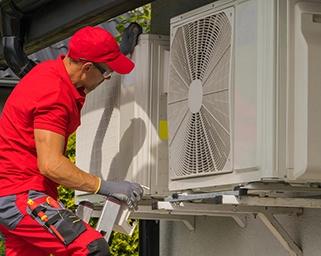How Long Should a Furnace Last?
Are you wondering how much longer your old furnace will last? Learn about the average furnace lifespan, how to prolong the life of a new or middle-aged furnace, and signs it’s time for furnace replacement.
By Anne Fonda
Your furnace works hard to keep your home and your family warm all winter long. If you’re in a northern state where the gas furnace runs from October through March or April, you want to get the most life out of your furnace. But you also want to plan for the expense of furnace replacement.
Keep reading to learn what you need to know about your furnace and old age.
The average lifespan of a furnace
In general, a homeowner can expect a furnace to last 15-20 years. Several factors contribute to furnace life expectancy, including:
Proper sizing and capacity
If the natural gas furnace isn’t properly sized for your home, it can wear out early - whether it’s oversized or undersized. This is why it’s vital to work with an HVAC professional who does precise sizing calculations.
Quality of installation
A furnace is only as good as its installation. Sloppy installation can shorten the life of your furnace and ductwork. Always work with a trained and licensed HVAC company, with up-to-date NATE certification.
Frequency of use and workload
The same furnace will last longer in a milder climate than it will in northern Minnesota or Massachusetts, for instance. The longer the winters and the harder the furnace works, in general, the shorter the lifespan.
Furnace maintenance
A well-maintained furnace will generally last longer than one that doesn’t get a yearly inspection and furnace tune-up. Keeping up with changing your furnace filters also affects the lifespan of the unit.
How old is your furnace?
If your home was newly constructed when you moved in, your furnace is the same age as your home - that’s an easy calculation. But if you moved into a pre-existing home, you may need to do a little detective work to figure out how old your furnace is.
If the previous owner left you with the owner’s manual or installation paperwork, check there for the installation date. Otherwise, you can go check the furnace itself. Look for a nameplate or sticker on the furnace.
Look for the MFG Date. That’s the manufacturing date, and the furnace was installed likely the same year. If there isn’t an MFG Date listed, make a note of the brand, model number, and serial number. You can look those up online to find out the age of your furnace.
If your furnace is more than 10 years old, pay closer attention to how well it is heating your home, since most furnace repairs happen during the last few years of its lifespan.
How to extend the lifespan of your furnace
We mentioned professional furnace maintenance and changing your furnace filters regularly as factors that can affect how long your furnace lasts. That’s because failing to keep up with regular maintenance can shorten your furnace’s lifespan.
The good news is that an excellent maintenance routine can help your furnace last longer. Changing your HVAC air filters at least every 30-90 days can help ensure that your HVAC system gets proper airflow to heat and cool your home. Not sure where your air filter is or how to change a furnace filter? Follow some of the links in this article for helpful information.
Not sure who to hire to be your furnace service provider? Read our blog on how to find the best HVAC service near me for some tips. Consider signing up for their HVAC maintenance plan to help keep your system running at peak performance year-round.
Schedule furnace repair as soon as you notice a problem
Beyond regular maintenance, another thing you can do to extend the life of your furnace is to schedule a furnace repair service as soon as you notice a problem. Small repairs are less expensive than the big repairs that can result from ignoring a problem.
If you get regular tuneups, call the same company for furnace repair. They know your system and any previous issues you have had.
5 top signs it’s time to consider furnace replacement
There are several indicators that it’s time to consider furnace replacement. An individual factor may be enough to convince you that now is the time, but when several of these factors are true, it becomes clearer that the sooner you replace your furnace, the sooner you can increase your comfort and increase the energy efficiency of your heating system.
- The furnace is 15+ years old - start budgeting and looking at replacement options. Old age combined with other factors can make replacing your furnace a more immediate prospect.
- Frequent breakdowns or repairs If you’re spending more and more on furnace repairs, it may be time to put that money toward a new furnace.
- Unusual noises or odors coming from the furnace Loud banging, booming, or grinding noises are not normal. Neither is a smell. These can all be indicators your furnace is failing. Consult with an HVAC professional.
- The furnace isn’t keeping you warm If an older furnace is struggling to warm your home to the winter thermostat settings you’d like, it may be time to replace your furnace.
- Increased energy bills If you have high energy bills that keep going up with no change in usage or increase in rates from the gas company, an inefficient older furnace is likely to blame. Today’s high-efficiency furnaces can save you on energy costs from Day 1.
Our Repair or Replace Guide has some additional information to help you decide what’s the right thing for your home.
Replacing your furnace: Top considerations
There are many factors to consider when deciding to replace your furnace. Briefly, these include:
- Proper furnace size and capacity for your home
- AFUE energy efficiency ratings
- Furnace technology
- Expert furnace installation
- Manufacturer’s warranty - Trane furnace warranties cover parts for 5-10 years, and warranty the heat exchanger for 20 years to the life of the furnace, depending on the unit.
- Cost
If your air conditioning unit is as old as your furnace, consider replacing it at the same time, or upgrading to a heat pump for a dual-fuel system. This may also help your furnace last longer as your heat pump can heat when the temperatures are not as extreme as they can be in deep winter.
Tax credits, rebates, and HVAC financing can all help you manage your furnace replacement cost.
Schedule furnace repair or a furnace replacement quote
If your furnace is blowing cold air, schedule a furnace repair appointment now. If you have an older furnace and you’re contemplating furnace replacement, find a local Trane dealer near you (or more than one) to schedule a free quote. Whether you need an HVAC expert on Long Island or the Minneapolis-St Paul metro area, we’ve got you covered.
Browse Trane furnaces.
Anne Fonda, Content Writer at Trane Technologies
A Content Writer with Trane Technologies, Anne Fonda researches topics and writes for Trane® and associated residential HVAC brands. She works in collaboration with Trane Technologies subject matter experts, offering easy-to-understand, informative content on complex topics. Her goal is to help consumers make informed decisions on the products and services they need.
She has written for HVAC and other service provider websites for over 16 years. Before transitioning to web content writing, Anne had a 14-year stint as an award-winning journalist. She graduated cum laude from the University of Missouri-Columbia School of Journalism. When she’s not working, Anne enjoys playing word games, reading, gardening, spending time with family, and visiting gardens and museums.
Expert review by John Kim, Senior Product Manager, Furnaces




